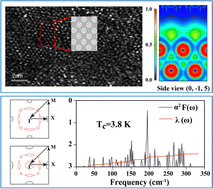A novel two-dimensional superconducting Ti layer: density functional theory and electron-beam irradiation†
Abstract
Since the discovery of graphene in an atomic thin layer format, many investigations have been conducted to search for two-dimensional (2D) layered materials, in which 3d-transition metals offer much new physics and great freedom of tunability. In this work, through electron-beam irradiation, we enable the manufacture of a new 2D Ti nanosheet from a suspension of Ti0.91O2 nanosheets. In state-of-the-art density functional theory (DFT), both empirical and linear response theory predicted that Hubbard Ueff values would be imposed, resulting in unstable phonon dispersion curves. In the end, the newly found Ti monolayer is confirmed to be a non-magnetic superconductor, with a medium level of electron–phonon coupling. The newly established Ti layer is quite robust under strain, and the evolution of local Dirac points in electronic bands is also analyzed in terms of linearity and energetic shift near the Fermi energy. As suggested by the Fermi surface, this metal monolayer experiences an electronic topological transition under strain. Our findings will encourage many more explorations of pure d metal-based isotopic monolayers with diverse structures and open a new playground for 2D superconductors and ultra-thin sensoring components.

- This article is part of the themed collection: New horizons in materials for energy conversion, optics and electronics


 Please wait while we load your content...
Please wait while we load your content...